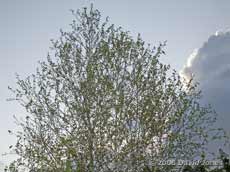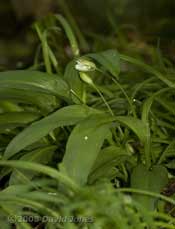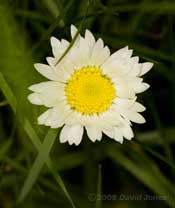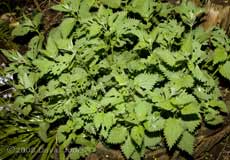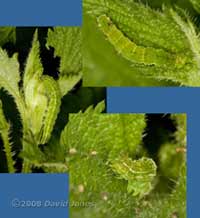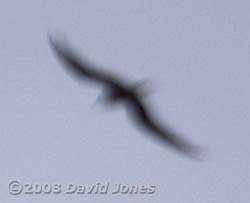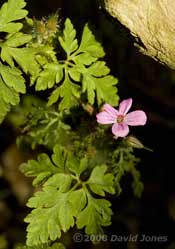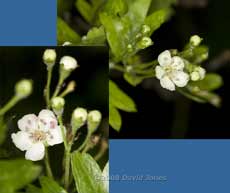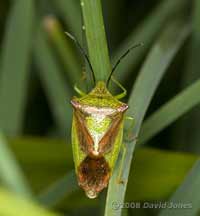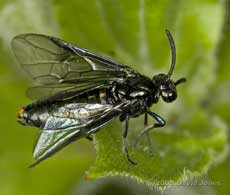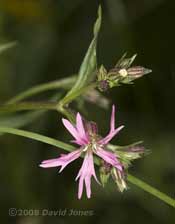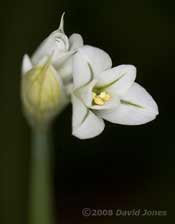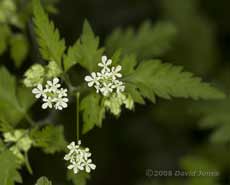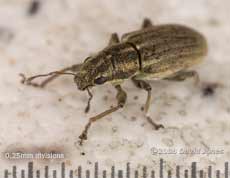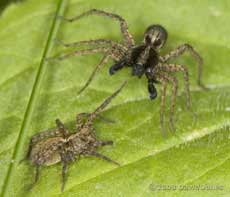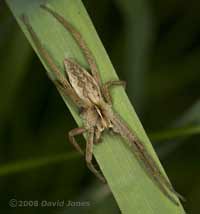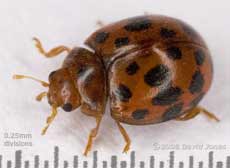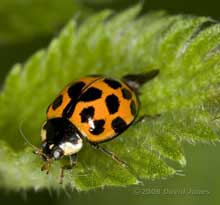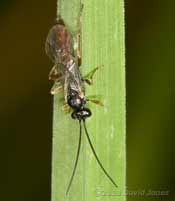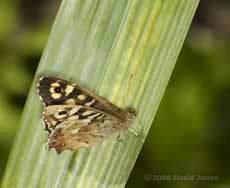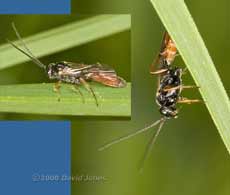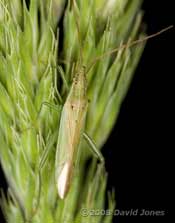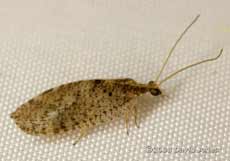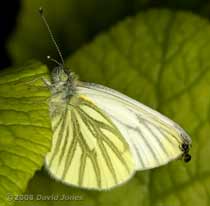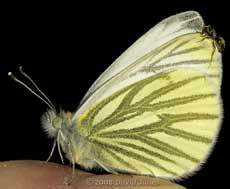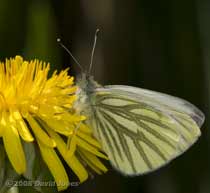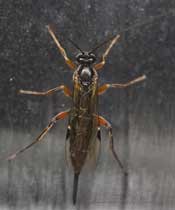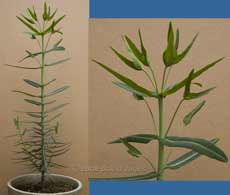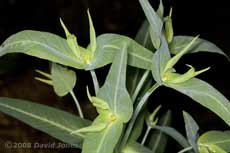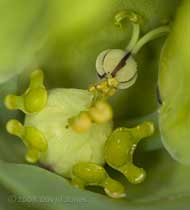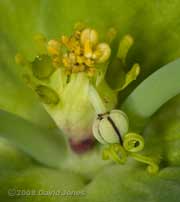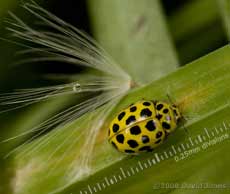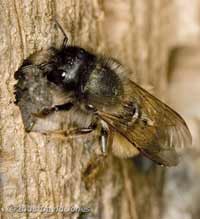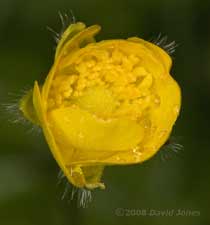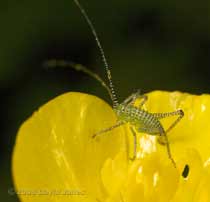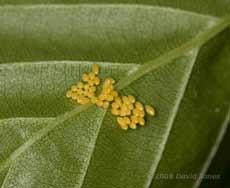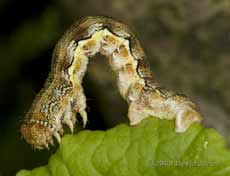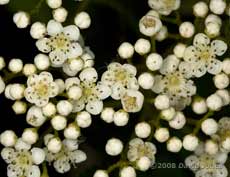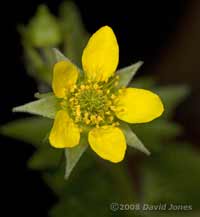Go to the last entry on this page .....Go to previous entry
Over the last couple of days the Birch has been starting to shed its male catkins as the leaves develop and the tree turns green.
I had wondered if the Hawthorn would come into flower today, but it was not to be. However, deep in the shade underneath it the first of the Ramson (wild Garlic - Allium ursinum) flowers is opening today.
One flower that opened a couple of days ago was this first Daisy (Bellis perennis) of the year.
Down under the Ivy tree the Stinging nettles have thrived, although the new leaves are already looking rather moth-eaten.
A close look revealed the culprits to be numerous green caterpillars like these. I have identified them in the past, but I'll need to look them up again.
Finally, a puzzle. This evening while I stood outside watching for Swifts, two birds flew low and fast just to the west of the garden and heading south-west. I didn't have a chance to focus on them before they disappeared and only managed to grab this blurred image (no larger version). They had slim, angular wings and a long, forked tail - the shape of a Tern. They appeared to be dark, but were seen against a bright evening sky, so I can't be sure about that.
2 May - A generally bright day, punctuated by a couple of showers in the afternoon.
A first flowering to report on tonight - several Herb-Robert flowers have opened, a few days later than last year. This is a plant that has thrived since I introduced it a couple of years ago. No unusual bird sightings today, but I did catch sight of several bats flying over us shortly before 9pm.
3 May - A dry day with lots of hazy sunshine during the morning. In the afternoon there was more high cloud and even a few drops of rain. The temperature reached close to 20C and it was pleasant enough the have our lunch outside. I took advantage of the good conditions to pull our caravan out from under its shelter and do some long overdue cleaning of the roof, so I didn't get round to using my camera in the garden today (other than down the nest box). That was a pity because I may have been able to photograph one of numerous Holly Blue butterflies that visited the garden (one posed beautifully on a Forget-me-not!) and a Speckled Wood butterfly (first one this year). There are now several Ramsons in flower, but we are still waiting for the hawthorn to flower. As I've mentioned in the nestbox diary, there were at least ten Swifts about today, and I heard their 'scream' for the first time this year. There was also a group of four House Martins about this morning. While I was watching them I also spotted a Buzzard very high overhead. Today the bird table and sunflower feeder have had frequent visits by a female Chaffinch which up to now has only been seen occasionally in the garden. Today she seemed so at home at the feeder that she continued to visit while we ate out lunch no more than six feet from her.
4 May - None of yesterday's sunshine, but it was mild today with a high of around 20C.
The Hawthorn has started flowering, a fortnight later than last year. The first flowering days for 2001-2007 were 13 May, 22 April, 24 April, 9 May, 1 May, 11 May and 20 April - quite a variable record.
Somewhat appropriately, perhaps, and standing out from the background in the grass next to the pond this morning was this Hawthorn Shieldbug (Acanthosoma haemorrhoidale), one of the few bugs I've seen so far this year.
And one more insect - this sawfly (Rhadinocerea micans) that relies on the Flag Irises as the only food plant for its larvae. With their four wings and dark body, these flutter around the pond almost like small moths.
5 May - After a grey and slightly damp start the day became bright and sunny with a high of over 21C. When I opened our bedroom curtain at around 7.30am I was treated to a very low fly-over by ten geese, right over our house and garden.
There were three new first flowerings to report on today. The first I noticed was a Ragged Robin next to the pond. These plants were introduced into the garden at the same time as the Red Campions but have been much slower to show signs of spreading, and so far have only appeared around the edge of the big pond.
The second is the Triangular-stalked Garlic (Allium triquetrum), this one by my workshop shed. There is no sign of flowers yet in the main group of these plants under the Hawthorn.
And the third new flowering is on what I think is Hedge Parsley (Torilis japonica), although I need to confirm that ID.
Just one insect photograph today, of a small weevil that landed on my kayak as I was cleaning it.
There are lots of spiders about now, and I must take some time to photograph more of them.
This pair was in the middle of courtship when I spotted them as the male vigorously waved his large, dark pedipalps towards the paler female. She stretched out a leg towards him several times but eventually lost interest and headed off to another leaf while he continued to display.
This spider always looks impressive when it stretches itself out along a blade of grass. I believe that it is a species called Tibellus oblongus which is common in damp habitats - I usually see them on plants at the side of the big pond.
A small technical note - I have added a FAVICON to the website which means that when you visits the website a small icon will appear to the left of the web address.
6 May - The summer weather continues, with sunshine all day and a high temperature of over 22C this afternoon. I've been struggling to stay awake today, but I was alert enough to spot a couple of firsts for the garden this morning. I'm afraid I'd made my usual mistake of walking down the garden without my camera when a Green Tortoise Beetle (Cassida viridis) landed on the side of our caravan, right in front of me. Needless to say it had left again by the time I returned with the camera.
However, just a few minutes later and I found and addition to the species of Ladybirds seen in the garden - a 24-spot Ladybird (Subcoccinella 24-punctata). Very small, it is covered with hairs and is a vegetarian, feeding on leaves. This individual was on grass next to the big pond.
Further down the garden, the Stinging nettles provided the place to find another many spotted ladybird. Unfortunately this much larger example is a Harlequin.
As well as the large number of solitary bees and hoverflies that are in the garden now, I'm starting to see more parasitic wasps about, including this small one perched on another grass blade by the pond. This Ichneumon fly looks very much like Diplazon laetatorius, which lays its eggs in the eggs of hoverflies.
I had just stood up after taking that last photograph when this Speckled Wood butterfly fluttered past, landing on the bamboo just long enough for me to grab this one photograph. There were also a couple of Holly Blues about today, but there was no chance to photograph them.
8 May - The warm, sunny weather continues, with a high approaching 25C again.
The ichneumon fly that features just above this entry was very much in evidence again today, along with at least half a dozen more, spending much of the day around the clump of tall grasses. I've not seen them other than singly in the past.
That same grass is coming into flower now, and the flower heads have already attracted a couple of examples of the Mirid Bug Stenodema laevigatum. This slender bug is abundant in long grass and its shape and colours help it to blend in with the grass flowers.
This Brown Lacewing species appears from time to time, and this one turned up when I shook a branch of the Berberis over an umbrella while checking the shrub for barkflies (none found!).
I came across an interesting encounter this morning. Numerous times in the past I've photographed ants struggling with live prey as they take it back to their nest. However, this morning I think the ant had 'bitten off more than it could chew'! I'd spotted this Green-veined White butterfly clambering about amongst the foliage of a Primrose plant. When I got closer I realised that it had an ant clinging to its wing. In fact, the ant was holding the wing firmly in its jaws, and it seemed that it was preventing the butterfly from flying away.
The butterfly was happy to walk onto my finger, and to give an idea of scale my fingernail is about 13mm long.
The ant eventually gave up (with a bit of help from me) and the butterfly flew off after a few minutes spent on a Dandelion. It's only the second time that I've recorded this species of butterfly in the garden, although it's possible that I may have mistakenly identified some as Small Whites when I've seen them in flight.
And tonight, a sawfly on our kitchen window, one that I've seen here in the past but I don't think I've ever actually identified it.
On a non-wildlife theme, I'm hoping someone can help me with a plant identification.
The flowers are within those structures at the ends of four stalks at the top of the plant and the two stalks that have developed from the leaf axils of the next pair of leaves.
The 'flowers' look very unusual, tucked down between pairs of leaves, along with another pair of developing stalks which also seem to be bearing flowers between another pair of leaves.
Looking very closely, I can see the stamens, one of which has started to release pollen from the anther in this picture. The banded sphere at the back appears to be the female part of the flower, with a divided and curled stigma.
I have no idea about the four strange structures seem in the lower part of the picture, but in this close-up of another flower, (photographed 24 hours later) you can see that the large disc on one of them is glistening - perhaps producing nectar? They may not be wild plants and are certainly not pretty, but we are watching them with some fascination!
9 May - There was a just bit of rain during last night, and this morning there is some high cloud about. Nevertheless, it was bright and warm - nearly 21C at 11.15am and approaching 25C in the afternoon. With hardly a breeze all day it felt quite humid. Thanks to Richard Clark who has pointed me in the right direction for my plant ID - it is a member of the Spurge family (Euphorbiaceae). Now I can concentrate my search, and hopefully get even closer in the near future. It also reminds me that I have long neglected the small spurges that grow naturally in my garden. I must turn my camera in their direction in the near future.
This morning, the long grass by the pond has yielded another of our native ladybirds for the 2008 diary, this time a 22-Spot Ladybird (Psyllobora 22-punctata) measuring just over 4mm in length. Like the larger Orange Ladybird that breeds in our Birch, it's a mildew feeder, but this species keeps to much nearer ground level. Interestingly, it is the only species of ladybird to have the same colours as larva, pupa and adult.
I've hardly mentioned the bee hotels so far this year. So far it seems that there is just the one solitary bee species that is visiting so far. This female is busy sealing the entrance to the hole she has laid her eggs in.
As they do this, the females are frequently 'buzzed' by the smaller males, and occasionally you can see a pair fall together to the ground. This pair were together for several minutes, but during that time they were repeatedly dived onto by other males before they headed (still together) for the shelter of the undergrowth.
I saw (but didn't get the chance to photograph) what I think is a female Sapyga quinquepunctatum which is a regular visitor to the bee hotels and is a parasitic wasp, its larvae dependent on the larvae of Mason Bees.
10 May - The present spell of unseasonably warm weather continues with what has been the hottest day of the year so far in our garden. The local weather stations recorded between 25 and 26C, while our garden thermometer which is in a shady spot reached over 29C, and it was humid!
We had a brief rain shower this evening, not heavy, but with big raindrops - I was in the bird box tower when it started and for a moment or two I wondered what was hitting the roof. It was only afterwards that I noticed that the first Buttercups had opened today, and then they had started to close for the night.
15 May - I'm afraid that there's just not enough time in the day at the moment, and I've not spent as much time as I would have liked in the garden during this good weather. Since the last entry, the high temperatures have been easing, with highs of 28C, 26C, 24C, 22C and 20C over these last five days, with no rain. But that is supposed to change tomorrow with some heavy rain and cool temperatures.
Just one photograph to add, but it's one of those special observations that I look forward to making each year - the first Speckled Bush Cricket nymph (Leptophyes punctatissima) of the year, 20 days earlier than in 2007.
Seen but photographed yesterday was what believe was a small 10-spot Ladybird (it disappeared before I could get a really good look), and my first damselfly of the year. It looked like a Small Red Damselfly, and it appeared to be egg-laying in the pond. Talking of the pond, today I heard the unmistakeable call of a toad coming from the thick vegetation between the two ponds. This is great to hear as I haven't seen a toad here for ages. As I mentioned in the nestbox diary, after hearing it first, I saw a Goldfinch fledgling by the feeders yesterday. It's the first Fledgling of any species I've seen here so far this Spring.
16 May - A cool, dull, overcast day with a high of just over 12C, but it stayed dry. The low cloud was lower than 1500ft, the height that aircraft sometimes pass over us as they make their approach to a local airfield - they were completely hidden from view today.
The latest plant to come into flower is the Elder next to the Hawthorn - just one inflorescence, with the rest looking as they have at least a few days' development to go.
When I looked out of the bedroom window this morning I thought that the Rowan had started flowering. However on a closer look I could see that one inflorescence is almost ready to burst, but not today. I have now identified the mystery plant photographed in the entry for 8 May. It's Caper Spurge (Euphorbia lathyris), which may or may not be a native species, according to where you look. In two of my plant books it is referred to as local in one, and rare in the other. It is a native species in Southern Europe, and it's very possible that it was introduced into the UK. Anyway, all parts of the plant are poisonous, and it can cause rashes when touched. It also spreads easily by seed and rhizomes so it may not be a good addition to the garden. The four plants are in pots at the moment, and I shall need to decide their fate before they go to seed.
17 May - After a bit of promising blue sky first thing this morning the low cloud returned and we had another dull, cool day with a high of about 13C. There was a bit of drizzle during the afternoon, and rain in the late evening. Only two pictures today, and they are both from last night when I did something I have not been doing for a while - a late evening walk down the garden with a torch.
First, some insect eggs, probably moth, under a leaf on the Birch.
I had noticed that some of the new leaves on the tree have already been devoured. I couldn't see any caterpillars on that branch, but I found this individual on the other side of the tree. With quite colourful patterns, it is one of the Geometridae, the caterpillars with just two useable pairs of prolegs at the rear end, and, as in this picture they loop their bodies. I had hoped to take another look at the Birch tonight but the rain has prevented that. The Rowan has not flowered today.
18 May - A bright and sunny morning but with much of the blue giving way to cloud by the middle of the day. The temperature got up to 15C, but a strong breeze meant it felt colder.
The waiting is over - the first flowers have opened on the Rowan. The trouble is, you need a tall step ladder to enjoy them!
Down near ground level another plant has also started flowering today - the Wood Avens (Geum urbanum). Click on images to see larger versions |
|
